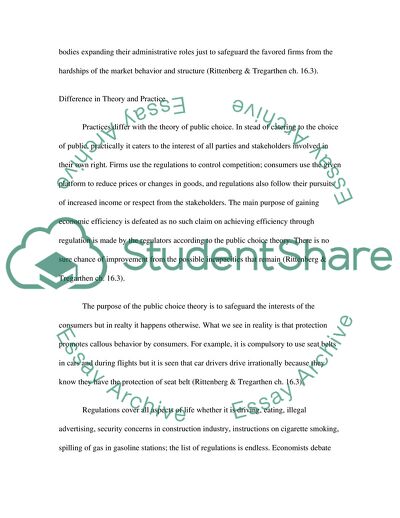
- Home
- Free Samples
- Premium Essays
- Editing Services
- Extra Tools
- Essay Writing Help
- About Us
- Studentshare
- Subjects
- Miscellaneous
- Public choice theory practices in the U.S and deregulations
Public choice theory practices in the U.S and deregulations - Essay Example

- Subject: Miscellaneous
- Type: Essay
- Level: Undergraduate
- Pages: 4 (1000 words)
- Downloads: 0
- Author: wintheiserzande
Extract of sample "Public choice theory practices in the U.S and deregulations"
16.3). Firms befool the regulators by asking them to control price competition. As regulators depend on the firms for providing crucial information, firms find means to convince the regulators as it suits their profitability. In stead of capturing firms for not serving the consumers’ interests, regulators meant to provide licenses and safeguarding other regulatory norms get “captured” by the firms they regulate (Rittenberg & Tregarthen ch. 16.3). Besides using the capture theory in their support, the advocates of public choice theory of regulation debate the integrity of the employees working in regulatory agencies who get motivated by personal interests rather than the interests of public.
They tend to serve their own selfish interests. So no purpose is served by the formation of regulatory bodies expanding their administrative roles just to safeguard the favored firms from the hardships of the market behavior and structure (Rittenberg & Tregarthen ch. 16.3). Practices differ with the theory of public choice. In stead of catering to the choice of public, practically it caters to the interest of all parties and stakeholders involved in their own right. Firms use the regulations to control competition; consumers use the given platform to reduce prices or changes in goods, and regulations also follow their pursuits of increased income or respect from the stakeholders.
The main purpose of gaining economic efficiency is defeated as no such claim on achieving efficiency through regulation is made by the regulators according to the public choice theory. There is no sure chance of improvement from the possible incapacities that remain (Rittenberg & Tregarthen ch. 16.3). The purpose of the public choice theory is to safeguard the interests of the consumers but in realty it happens otherwise. What we see in reality is that protection promotes callous behavior by consumers.
For example, it is compulsory to use seat
...Download file to see next pages Read MoreCHECK THESE SAMPLES OF Public choice theory practices in the U.S and deregulations
Critically Analyse the Role and Value of 'The Community' in Global Justice Theory
Expediency of Federal Regulations in Eliminating Corporate Financial Fraud
Differences Between Institutionalism and Rational Choice Theory
Airline Deregulation Act of 1978
Government Deregulation and Business
Theory and Practice of Deregulation: the Prevalence of Free Markets
Critically Analyse the Role and Value of 'the Community in Global Justice Theory
Management Theory and Practice

- TERMS & CONDITIONS
- PRIVACY POLICY
- COOKIES POLICY